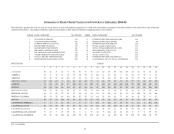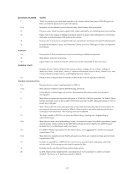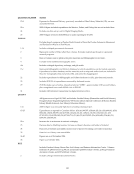100
Questions 14-20. Expenditures. Report all expenditures of funds that come to the library from the regular
institutional budget, and from sources such as research grants, special projects, gifts and endowments, and fees for
service. (For question 17, include non-library funds see instruction Q17.) Do not report encumbrances of funds
that have not yet been expended. Canadian libraries should report expenditures in Canadian dollars. (For your
information, if interested in determining figures in U.S. dollars, divide Canadian dollar amounts by 1.24971, the
average monthly noon exchange rate published in the Bank of Canada Review for the period July 2004-June 2005.)
Please round figures to the nearest dollar.
Question 15a. Monographs. Report expenditures for volumes counted on line 2.
Question 15b. Current Serials. Report expenditures for serials counted on line 4a. Exclude unnumbered
monographic and publishers’ series, and encumbrances.
Question 15c. Other library materials. Include expenditures for all materials not reported in Questions 15a and
15b, e.g., backfiles of serials, charts and maps, audiovisual materials, manuscripts, etc. If expenditures for these
materials are included in lines 15a and/or 15b and cannot be disaggregated, please report U/A and provide a
footnote. Do not include encumbrances.
Question 15d. Miscellaneous expenditures. Include any other materials funds expenditures not included in
questions 15a-c, e.g., expenditures for bibliographic utilities, literature searching, security devices, memberships for
the purposes of publications, etc. Please list categories, with amounts, in a footnote. Note: If your library does not
use materials funds for non-materials expenditures—i.e., such expenditures are included in “Other Operating
Expenditures”— report 0, not U/A, on line 15d.
Question 16. Contract Binding. Include only contract expenditures for binding done outside the library. If all
binding is done in-house, state this fact and give in-house expenditures in a footnote do not include personnel
expenditures. (This figure should also be reported in the 2004-05 ARL Preservation Survey, question 7b.)
Questions 17. Salaries and wages. Exclude fringe benefits. If professional and support staff salaries cannot be
separated, enter U/A, on lines 17a and 17b and enter total staff on line 17.
Question 17c. Salaries and wages: Student Assistants. Report 100% of student wages regardless of budgetary
source of funds. Include federal and local funds for work study students.
Question 19. Other operating expenditures. Exclude expenditures for buildings, maintenance, and fringe
benefits.
Questions 21-25. Electronic materials expenditures. These items are intended to indicate what portion of your
institution’s total library expenditures are dedicated to electronic resources and services. Please use the Footnotes to
indicate any electronic materials expenditures you believe not to be covered by these questions. Many
expenditures recorded in these questions should have been included in Question 20, total library
expenditures.
Question 21. Computer files. Report expenditures that are not current serials (i.e. are non-subscription, one-time,
or monographic in nature) for software and machine-readable materials considered part of the collections. Examples
include periodical backfiles, literature collections, one-time costs for JSTOR membership, etc. Expenditures
reported here may be derived from any of the following categories: Monographs (Q15a), Other Library Materials
(Q15c), Miscellaneous (Q15d), or Other Operating Expenditures (Q19).
Question 22. Electronic Serials. Report subscription expenditures (or those which are expected to be ongoing
commitments) for serial publications whose primary format is electronic and for online searches of remote databases
such as OCLC FirstSearch, DIALOG, Lexis-Nexis, etc. Examples include paid subscriptions for electronic journals
and indexes/abstracts available via the Internet, CD-ROM serials, and annual access fees for resources purchased on
a “one-time” basis, such as literature collections, JSTOR membership, etc. Not all items whose expenditures are
counted here will be included in Total Current Serials (Question 4) or Current Serial Expenditures (Question 15b).
Questions 14-20. Expenditures. Report all expenditures of funds that come to the library from the regular
institutional budget, and from sources such as research grants, special projects, gifts and endowments, and fees for
service. (For question 17, include non-library funds see instruction Q17.) Do not report encumbrances of funds
that have not yet been expended. Canadian libraries should report expenditures in Canadian dollars. (For your
information, if interested in determining figures in U.S. dollars, divide Canadian dollar amounts by 1.24971, the
average monthly noon exchange rate published in the Bank of Canada Review for the period July 2004-June 2005.)
Please round figures to the nearest dollar.
Question 15a. Monographs. Report expenditures for volumes counted on line 2.
Question 15b. Current Serials. Report expenditures for serials counted on line 4a. Exclude unnumbered
monographic and publishers’ series, and encumbrances.
Question 15c. Other library materials. Include expenditures for all materials not reported in Questions 15a and
15b, e.g., backfiles of serials, charts and maps, audiovisual materials, manuscripts, etc. If expenditures for these
materials are included in lines 15a and/or 15b and cannot be disaggregated, please report U/A and provide a
footnote. Do not include encumbrances.
Question 15d. Miscellaneous expenditures. Include any other materials funds expenditures not included in
questions 15a-c, e.g., expenditures for bibliographic utilities, literature searching, security devices, memberships for
the purposes of publications, etc. Please list categories, with amounts, in a footnote. Note: If your library does not
use materials funds for non-materials expenditures—i.e., such expenditures are included in “Other Operating
Expenditures”— report 0, not U/A, on line 15d.
Question 16. Contract Binding. Include only contract expenditures for binding done outside the library. If all
binding is done in-house, state this fact and give in-house expenditures in a footnote do not include personnel
expenditures. (This figure should also be reported in the 2004-05 ARL Preservation Survey, question 7b.)
Questions 17. Salaries and wages. Exclude fringe benefits. If professional and support staff salaries cannot be
separated, enter U/A, on lines 17a and 17b and enter total staff on line 17.
Question 17c. Salaries and wages: Student Assistants. Report 100% of student wages regardless of budgetary
source of funds. Include federal and local funds for work study students.
Question 19. Other operating expenditures. Exclude expenditures for buildings, maintenance, and fringe
benefits.
Questions 21-25. Electronic materials expenditures. These items are intended to indicate what portion of your
institution’s total library expenditures are dedicated to electronic resources and services. Please use the Footnotes to
indicate any electronic materials expenditures you believe not to be covered by these questions. Many
expenditures recorded in these questions should have been included in Question 20, total library
expenditures.
Question 21. Computer files. Report expenditures that are not current serials (i.e. are non-subscription, one-time,
or monographic in nature) for software and machine-readable materials considered part of the collections. Examples
include periodical backfiles, literature collections, one-time costs for JSTOR membership, etc. Expenditures
reported here may be derived from any of the following categories: Monographs (Q15a), Other Library Materials
(Q15c), Miscellaneous (Q15d), or Other Operating Expenditures (Q19).
Question 22. Electronic Serials. Report subscription expenditures (or those which are expected to be ongoing
commitments) for serial publications whose primary format is electronic and for online searches of remote databases
such as OCLC FirstSearch, DIALOG, Lexis-Nexis, etc. Examples include paid subscriptions for electronic journals
and indexes/abstracts available via the Internet, CD-ROM serials, and annual access fees for resources purchased on
a “one-time” basis, such as literature collections, JSTOR membership, etc. Not all items whose expenditures are
counted here will be included in Total Current Serials (Question 4) or Current Serial Expenditures (Question 15b).




















































































































































